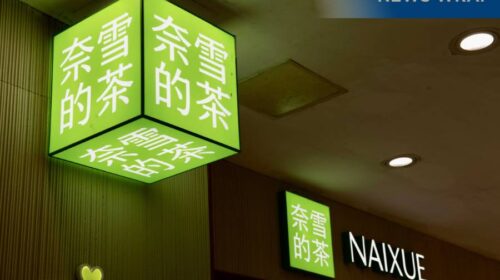Nayuki serves up cup of red ink in China’s overheated tea wars

The bubble tea chain’s revenue slipped 1.9% in the first half of the year, as an 8% decline for its self-operated stores was mostly offset by gains for its newer franchising business
Key Takeaways:
- Nayuki slipped into the red in the first half of the year, as its margins plunged on sharply lower sales per store amid growing consumer caution
- The company’s stock is valued far lower than its more aggressive peers that have far bigger store networks using a franchise business model
By Doug Young
The bitter taste of losses is brewing in China’s overheated bubble tea economy, where Nayuki Holdings Ltd. (2150.HK) has become one of the first major players to slip into the red.
Nayuki’s latest earnings report is filled with trouble signs reflecting the industry’s current state of cutthroat competition, which is being exacerbated by growing consumer caution as China’s economy slows. The worrisome signals include sliding revenue per store, partly due to a big drop in the average size of each customer order.
Rising labor and raw material costs didn’t help either, causing Nayuki’s store-level operating margin to tank by 12.3 percentage points to 7.8% during the first six months of this year from 20.1% a year earlier, according to the company’s latest financial report released last week. As a result, Nayuki, which also uses the name Naixue, slipped into the red with a net loss of 435 million yuan ($61 million) for the period, reversing a profit of 66 million yuan a year earlier.
The company blamed weak consumer demand for its woes, together with a “base effect” that made its year-ago comparisons unusually high as Chinese rushed out to celebrate with little luxuries like cups of bubble tea with the end of pandemic restrictions in the first half of 2023. That brief bubble of post-pandemic euphoria has long since burst, bringing us to the current market of weak consumer sentiment and a highly overbuilt bubble tea market.
Nayuki had the luxury of being the only Chinese bubble tea choice for international investors for nearly three years, following its Hong Kong listing in 2021. But that changed in April this year with the listing of ChaPanda (2555.HK), a much larger chain that differs from Nayuki in the former’s use of a pure franchising model compared with Nayuki’s use of mostly self-operated stores.
At the same time, several other tea chains, including leader Mixue, as well as others like Guming and Auntea Jenny, have also filed for Hong Kong listings but have yet to make IPOs. Nayuki is the small fry in the group in terms of store count, with about 2,000 shops in its network at the end of June. By comparison, ChaPanda has used its franchising model to rapidly grow its network to 8,385 stores by the end of June, up 21% from a year earlier. Mixue is at the top of the teapot with a whopping 36,000 stores as of last September.
Investors haven’t exactly flooded into any of the existing tea stocks, which probably partly explains why only ChaPanda has moved ahead with its listing among all the companies that have applied for recent IPOs. ChaPanda’s stock has tanked nearly 60% since its trading debut, while Nayuki’s shares are down by a similar 56% this year.
Between that pair, investors clearly favor ChaPanda and its franchising model. That model has also helped ChaPanda remain profitable, though its profit fell by about half in the first half of this year to 237 million yuan. ChaPanda trades at a price-to-sales (P/S) ratio of 1.68, or about four times Nayuki’s 0.42. Leading Chinese coffee chain Luckin (LKNCY.US), which has also grown rapidly using a franchise model, is similar to ChaPanda with a P/S ratio of 1.58.
Consumption downgrade
Next, we’ll take a deeper dive into the stormy teapot that is Nayuki’s latest financial report, which is almost completely filled with falling metrics. The company’s top-line revenue fell 1.9% to 2.54 billion yuan in the first half of this year from 2.59 billion yuan a year earlier, which initially looks not so bad when one considers the previously mentioned high base effect from the year-ago period.
But a closer inspection shows revenue from Nayuki’s self-operated stores actually fell by a larger 8% to 2.1 billion yuan during the period. That decline was mostly offset by a buildup in the company’s franchise business, which just launched in the second half of last year and included nearly 300 stores by the end of June.
Nayuki wasn’t sitting still as its rivals rushed to open new stores, though its rate of expansion was much slower. The company’s self-operated store count stood at 1,597 at the end of June, up 1.5% from a year earlier, though its overall store growth rate was much higher when you include the addition of its new franchised stores.
Of all the company’s metrics, the most worrisome are the sharp declines in average order size and average sales per store. Both trends reflect growing consumer caution in China over the last year, as people worry about things like job security and falling property prices.
As that happens, big-ticket items like computer and car purchases are taking the biggest hit, though people are also less willing to splash out on other non-essentials like premium teas. That’s pressuring companies like Nayuki, traditionally considered one of the higher-end teahouses, to lower its prices that traditionally average 20 yuan or more per cup. It’s also playing to the advantage of rivals like Mixue, known for their cheaper products sometimes costing as little as 9.9 yuan.
Nayuki said its average order dropped 15% to 27.5 yuan in the latest reporting period from 32.4 yuan a year earlier. Its average orders per teahouse per day dropped by an even larger 27% to 266 from 363 a year earlier, as more people skipped a bubble tea to save some money.
While its revenue-per-store was falling, the same wasn’t true for Nayuki’s labor, rent and raw material costs, which all rose as a percentage of overall revenue, partly due to its franchising expansion. The end result was the sharply lower margins, and drop into the red that we previously mentioned.
There’s really not much to get excited about with Nayuki these days, unless you think its low P/S ratio could present a buying opportunity. It’s being rapidly overtaken by more aggressive rivals, and it’s quite likely the company will remain in the red for at least the next year or two. Meantime, some of the other IPO candidates are likely to finally make it to market over the next year, providing investors with some new flavors to choose from in this overheated sector.
To subscribe to Bamboo Works free weekly newsletter, click here






